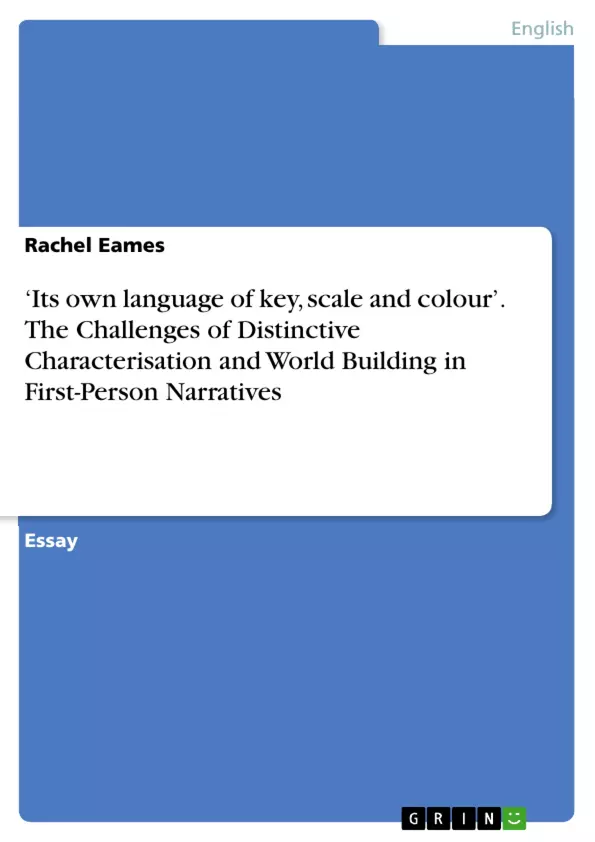‘Each in its own language of key, scale and colour,’ says David Mitchell’s composer, Robert Frobisher, describing his magnum opus, "The Cloud Atlas Sextet". ‘Revolutionary or gimmicky? Shan’t know until it’s finished’ (2004, p.463). Here David Mitchell captures the artistic process he knows well; Frobisher’s medium is the music of ‘cello, flute, oboe and violin’, but if Frobisher was a writer, he could easily be talking about character voices. Indeed, the sextet is a microcosm of Cloud Atlas (2004) itself, sharing a name and concept with the Russian doll of nested narratives, each narrator vivid and distinguishable from the last.
The first-person narrative mode offers a range of possibilities for a novelist. Mitchell calls it ‘the most intimate voice’ (Pauli, 2004), and "Cloud Atlas" showcases the flexibility of the mode across a range of settings, genres and time periods. Other novelists, such as Barbara Kingsolver, see the subjectivity of the first-person as an opportunity to explore different perspectives of events. "The Poisonwood Bible" (2008) follows a rotational narrative of contrapuntal chapters, from the point-of-view of each of the women in the Price family, to ‘create a moral conversation’ (Kingsolver, 2012).
My own novel, "Fairweather" (2014), a historical detective novel set in Victorian London, told in part from the perspective of a serial conman and opportunist, experiments with the flexibility of a single voice. Though very different, both in genre and structural approach, each of these novels uses the ‘key, scale and colour’ of language to bring life to their narrators and the stories they tell.
Inhaltsverzeichnis (Table of Contents)
- ‘ITS OWN LANGUAGE OF KEY, SCALE AND COLOUR’
- THE CHALLENGES OF DISTINCTIVE CHARACTERISATION AND WORLD BUILDING IN FIRST-PERSON NARRATIVES
- Key
- Scale
- Colour
Zielsetzung und Themenschwerpunkte (Objectives and Key Themes)
This article explores the challenges of distinctive characterisation and world building in first-person narratives. It examines how key, scale, and colour can be used to create compelling and unique characters and stories.
- The importance of voice in first-person narration
- The role of key in conveying character
- The impact of scale on narrative structure
- The use of colour to create a sense of place and atmosphere
- The challenges of maintaining consistency in character voice across a long narrative
Zusammenfassung der Kapitel (Chapter Summaries)
- The article begins by defining the key, scale, and colour of language, and how these elements can be used to create distinctive characters and stories. It draws on examples from David Mitchell's Cloud Atlas and Barbara Kingsolver's The Poisonwood Bible to illustrate these concepts.
- The article then discusses the challenges of maintaining consistency in character voice across a long narrative, and how different authors have approached this problem. It examines the use of idiomatic language, register, and lexical field in shaping character voice.
- The article concludes by considering the impact of scale on narrative structure, and how different authors have used scale to create different kinds of stories. It compares the linear structure of Kingsolver's novel to the more complex structure of Mitchell's Cloud Atlas.
Schlüsselwörter (Keywords)
The main keywords and focus topics of the text include first-person narration, characterisation, world building, key, scale, colour, voice, idiom, register, lexical field, narrative structure, and the use of examples from David Mitchell's Cloud Atlas and Barbara Kingsolver's The Poisonwood Bible.
- Quote paper
- Rachel Eames (Author), 2014, ‘Its own language of key, scale and colour’. The Challenges of Distinctive Characterisation and World Building in First-Person Narratives, Munich, GRIN Verlag, https://www.grin.com/document/334619



